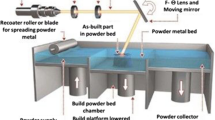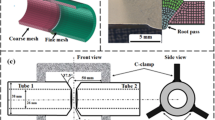Abstract
Residual stresses deteriorate strength of materials affecting the quality of industrial products. A removal or reduction of the residual stresses is an essential procedure in successful engineering component development. Effective and convenient methods are necessary for detection and evaluation of residual stresses. In this paper Hole Drilling Method is chosen for identification and a quantitative determination of the residual stresses in specimens of two groups under different laser welding speed conditions, 4.1m/min and 5.1m/min. The lap joints welded with STS 301L sheet of two different speeds were investigated along the welding line at two locations, the middle and the end location in the heat affected zone (HAZ). The identification of HAZ is carried out by taking hardness values from weld centerline to the raw material. Based on the experimental results and analysis, it is found that higher welding speed reduces the residual stresses. Also, the end location is found to be higher residual stress area compared with middle location due to the convective boundary condition. The residual stresses decrease as the depth increases from the top surface due to the lower heat input to depth increments.
Similar content being viewed by others
References
Measurement Group, “Measurement of Residual Stresses by the Hole-Drilling Strain Gage Method,” Tech Note TN-503, 1993.
Zang, G., Eibl, M., Singh, S., Hahn, O. and Kurzok, J. R., “Methods of Predicting the Fatigue Lives of Laser Beam Welded Lap Welds Subjected to Shear Stresses,” Welding Research Abroad, Vol. 48, Issue 10, pp. 11–18, 2002.
Shimokusu, Y., Fukumoto, S., Nayama, M., Ishide, T. and Tsubota, S., “Application of High Power YAG Laser Welding to Stainless Steel Tanks,” Mitsubishi Heavy Industries, Ltd. Technical Review, Vol. 38, No. 1, pp. 1–5, 2001.
Olabi, A. G., Benyounis, K. Y. and Hashmi, M. S. J., “Application of Response Surface Methodology in Describing the Residual Stress Distribution in CO2 Laser Welding of AISI304,” Strain, Vol. 43, Issue 1, pp. 37–46, 2007.
Costa, J. M., Pires, J. T. B., Antunes, F., Nobre, J. P. and Borrego, L. P., “Residual Stresses Analysis of ND-YAG Laser Welded Joints,” Engineering Failure Analysis, Vol. 17, No. 1, pp. 28–37, 2010.
Cho, S. K., Yang, Y. S., Son, K. J. and Kim, J. Y., “Fatigue Strength in Laser Welding of the Lap Joint,” Journal of Finite Elements in Analysis and Design, Vol. 40, No. 9, pp. 1059–1070, 2004.
Labeas, G., Tsirkas, S., Diamantakos, J. and Kermanidis., A., “Effect of Residual Stresses due to Laser Welding on the Stress Intensity Factors of Adjacent Crack,” Proc. of 11th International Conference on Fracture, 2005.
Mathar, J., “Determining of Initial Stresses by Measuring the Deformation around Drilled Holes,” Trans. of ASME, Vol. 56, No. 4, pp. 249–254, 1934.
Niku-Lari, A., Lu, J. and Flavenot, J. F., “Measurement of Residual Stress Distribution by the Incremental Hole-Drilling method,” Experimental Mechanics, Vol. 25, No. 6, pp. 175–185, 1986.
ASTM E837-99 Standard Test Method, “Determining Residual Stresses by the Hole-Drilling Strain-Gage Method,” 1999.
Timoshenko, S. P. and Goodier, J. N., “Theory of Elasticity: third edition,” MacGraw Hill International Book, 1982.
Schajer, G. S., “Application of Finite Element Calculations to Residual Stress Measurement,” Journal of Engineering Materials and Technology, Vol. 103, pp. 157–163, 1981.
Rendler, N. J. and Vigness, I., “Hole Drilling Strain Gage Method of Measuring Residual Stresses,” Proc., SESA XXIII, No. 2, pp. 577–586, 1966.
Kelsey, R. A., “Measuring Non-uniform Residual Stresses by the Hole drilling Method,” Proc., SESA XIV, No. 1, pp. 181–194, 1956.
Schajer, G. S., “Measurement of Non-Uniform Residual Stresses Using the Hole-Drilling Method,” Journal of Engineering Materials and Technology, Vol. 110, No. 4, pp. 338–343, 1988.
Choo, B. Y. and Keum, Y. T., “Evaluation of mechanical properties of Welded metal in Tailored steel Sheet Welded by CO2 Laser,” J. of KSPE, Vol. 18, No. 4, pp. 142–150, 2001.
Chun, K. J., Yoo, O. S., Won, Y. Y. and Lee, J. Y., “Morphological study and stress analysis of Korean Mandibular second premolar,” IJPEM, Vol. 10, No. 3, pp. 141–145, 2009.
Author information
Authors and Affiliations
Corresponding author
Rights and permissions
About this article
Cite this article
Park, M.K., Sindhu, R.A., Lee, S.J. et al. A residual stress evaluation in laser welded lap joint with hole drilling method. Int. J. Precis. Eng. Manuf. 10, 89–95 (2009). https://doi.org/10.1007/s12541-009-0099-8
Received:
Accepted:
Published:
Issue Date:
DOI: https://doi.org/10.1007/s12541-009-0099-8




